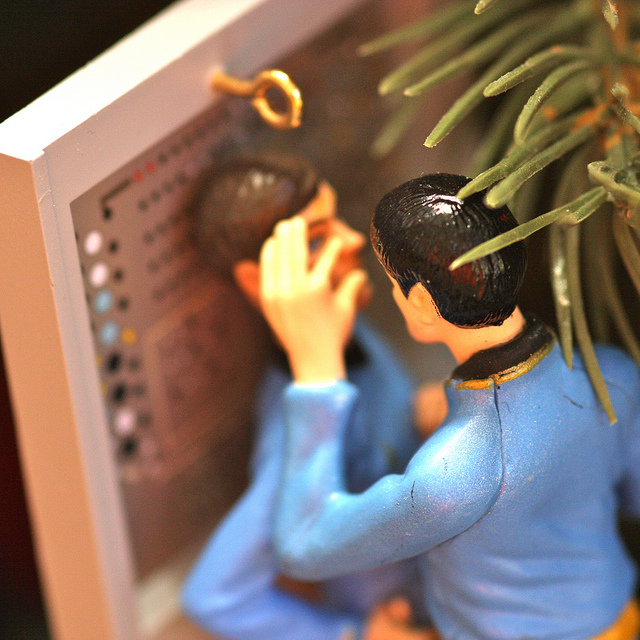Archive for March, 2018
Creating the Causes and Conditions for New Behavior to Grow
 When you see emergent behavior that could grow into a powerful new theme, it’s important to acknowledge the behavior quickly and most publicly. If you see it in person, praise the behavior in front of everyone. Explain why you like it, explain why it’s important, explain what it could become. And as soon as you can find a computer, send an email to their bosses and copy the right-doers. Tell their bosses why you like it, tell them why it’s important, tell them what it could become.
When you see emergent behavior that could grow into a powerful new theme, it’s important to acknowledge the behavior quickly and most publicly. If you see it in person, praise the behavior in front of everyone. Explain why you like it, explain why it’s important, explain what it could become. And as soon as you can find a computer, send an email to their bosses and copy the right-doers. Tell their bosses why you like it, tell them why it’s important, tell them what it could become.
Emergent behavior is like the first shoots of a beautiful orchid that may come to be. To the untrained eye, these little green beauties can look like scraggly weeds pushing out of the dirt. To the tired, overworked leader these new behaviors can like divergence, goofing around and even misbehavior. Without studying the leaves, the fledgling orchid can be confused for crabgrass.
Without initiative there is no new behavior and without new behavior there can be no orchids. When good people solve a problem in a creative way and it goes unacknowledged, the stem of the emergent behavior is clipped. But when the creativity is watered and fertilized the seedling has a chance to grow into something more. The leaders’ time and attention provide the nutrients, the leaders’ praise provides the hydration and their proactive advocacy for more of the wonderful behavior provides the sunlight to fuel the photosynthesis.
When the company demands bushels of grain, it’s a challenge to keep an eye out for the early signs of what could be orchids in the making. But that’s what a leader must do. More often than not, this emergent behavior, this magical behavior, goes unacknowledged if not unnoticed. As leaders, this behavior is unskillful. As leaders, we’ve got to slow down and pay more attention.
When you see the magic in emergent behavior, when you see the revolution it could grow into, and when you look someone in the eye and say – “I’ve got to tell you, what you did was crazy good. What you did could turn things upside down. What you did was inspiring. Thank you.” – you get people’s attention. Not only to do you get the attention of the person you’re talking to, you get the attention of everyone within a ten-foot radius. And thirty minutes later, almost everyone knows about the emergent behavior and the warm sunshine it attracted.
And, magically, without a corporate initiative or top-down deployment, over the next weeks there will be patches of orchids sprouting under desks, behind filing cabinets, on the manufacturing floor, in the engineering labs and in the common areas.
As leaders we must make it easier for new behavior to happen. We must figure a way to slow down and pay attention so we can recognize the seeds of could-be greatness. And to be able to invest the emotional energy needed to protect the seedlings, we must be well-rested. And like we know to provide the right soil, the right fertilizer, the right watering schedule and the right sunlight, we must remember that special behavior we want to grow is a result of causes and conditions we create.
Image credit – Rosemarie Crisasfi
With novelty, less can be more.
 When it’s time to create something new, most people try to imagine the future and then put a plan together to make it happen. There’s lots of talk about the idealize future state, cries for a clean slate design or an edict for a greenfield solution. Truth is, that’s a recipe for disaster. Truth is, there is no such thing as a clean slate or green field. And because there are an infinite number of future states, it’s highly improbable your idealized future state is the one the universe will choose to make real.
When it’s time to create something new, most people try to imagine the future and then put a plan together to make it happen. There’s lots of talk about the idealize future state, cries for a clean slate design or an edict for a greenfield solution. Truth is, that’s a recipe for disaster. Truth is, there is no such thing as a clean slate or green field. And because there are an infinite number of future states, it’s highly improbable your idealized future state is the one the universe will choose to make real.
To create something new, don’t look to the future. Instead, sit in the present and understand the system as it is. Define the major elements and what they do. Define connections among the elements. Create a functional diagram using blocks for the major elements, using a noun to name each block, and use arrows to define the interactions between the elements, using a verb to label each arrow. This sounds like a complete waste of time because it’s assumed that everyone knows how the current state system behaves. The system has been the backbone of our success, of course everyone knows the inputs, the outputs, who does what and why they do it.
I have created countless functional models of as-is systems and never has everyone agreed on how it works. More strongly, most of the time the group of experts can’t even create a complete model of the as-is system without doing some digging. And even after three iterations of the model, some think it’s complete, some think it’s incomplete and others think it’s wrong. And, sometimes, the team must run experiments to determine how things work. How can you imagine an idealized future state when you don’t understand the system as it is? The short answer – you can’t.
And once there’s a common understanding of the system as it is, if there’s a call for a clean sheet design, run away. A call for a clean sheet design is sure fire sign that company leadership doesn’t know what they’re doing. When creating something new it’s best to inject the minimum level of novelty and reuse the rest (of the system as it is). If you can get away with 1% novelty and 99% reuse, do it. Novelty, by definition, hasn’t been done before. And things that have never been done before don’t happen quickly, if they happen at all. There’s no extra credit for maximizing novelty. Think of novelty like ghost pepper sauce – a little goes a long way. If you want to know how to handle novelty, imagine a clean sheet design and do the opposite.
Greenfield designs should be avoided like the plague. The existing system has coevolved with its end users so that the system satisfies the right needs, the users know how to use the system and they know what to expect from it. In a hand-in-glove way, the as-is system is comfortable for end users because it fits them. And that’s a big deal. Any deviation from baseline design (novelty) will create discomfort and stress for end users, even if that novelty is responsible for the enhancement you’re trying to deliver. Novelty violates customer expectations and violating customer expectations is a dangerous game. Again, when you think novelty, think ghost peppers. If you want to know how to handle novelty, imagine a green field and do the opposite.
This approach is not incrementalism. Where you need novelty, inject it. And where you don’t need it, reuse. Design the system to maximize new value but do it with minimum novelty. Or, better still, offer less with far less. Think 90% of the value with 10% of the cost.
Image credit – Laurie Rantala
Thoughts on Selling
 Like most things, selling is about people.
Like most things, selling is about people.
The hard sell has nothing to do with selling.
Just when you think you’re having the least influence, you’re having the most.
When – ready, sell, listen – has run its course, try – ready, listen, sell.
Regardless of how politely it’s asked, “How many do you want?” isn’t selling.
If sales people are compensated by sales dollars, why do you think they’ll sell strategically?
The time horizon for selling defines the selling.
When people think you’re selling, they’re not thinking about buying.
Selling is more about ears than mouths.
Selling on price is a race to the bottom.
Wanting sales people to develop relationships is a great idea; why not make it worth their while?
Solving customer problems is selling.
Making it easy to buy makes it easy to sell.
You can’t sell much without trust.
Sell like you expect your first sale will happen a year from now.
Selling is a result.
I’m not sure the best way to sell; but listening can’t hurt.
Over-promising isn’t selling, unless you only want to sell once.
Helping customers grow is selling.
Delaying gratification is exceptionally difficult, but it’s wonderful way to sell.
Ground yourself in the customers’ work and the selling will take care of itself.
People buy from people and people sell to people.
Image credit – Kevin Dooley
A Healthy Dose of Heresy
 Anything worth its salt will meet with resistance. More strongly, if you get no resistance, don’t bother.
Anything worth its salt will meet with resistance. More strongly, if you get no resistance, don’t bother.
There’s huge momentum around doing what worked last time. Same as last time but better; build on success; leverage last year’s investment; we know how to do it. Why are these arguments so appealing? Two words: comfort and perceived risk. Why these arguments shouldn’t be so appealing: complacency and opportunity cost.
We think statically and selectively. We look in the rear view mirror, write down what happened and say “let’s do that again.” Hey, why not? We made the initial investment and did the leg work. We created the script. Let’s get some mileage out of it. And we selectively remember the positive elements and actively forget the uncertainty of the moment. We had no idea it was going to work, and we forget that part. It worked better than we imagined and we remember the “working better” part. And we forget we imagined it would go differently. And we forget that was a long time ago and we don’t take the time to realize things are different now. The rules are dynamic, yet our thinking is static.
We compete with the past tense. We did this and they did that, and, therefore, that’s what will happen again. So wrong. We’ve got smarter; they’ve got smarter; battery capacity has tripled; power electronics are twice as efficient; efficiency of solar panels has doubled; CRISPR can edit our genes. The rules are different but the sheet music hasn’t changed. The established players sing the same songs and the upstarts cut them off at the knees.
If you were successful last time and everyone thinks your proposed project is a good idea, ball it up and throw it in the trash. It reeks of stale thinking. If your project plan is dismissed by the experts because it contradicts the tired recipe of success, congratulations! You may be onto something! Stomp on the accelerator and don’t look back.
If your proposal meets with consensus, hang your head and try again. You missed the mark. If they scream “heretic” and want to burn you at the stake, double down. If the CEO isn’t adamantly against it, you’re not trying hard enough. If she throws you out of the room half way through your presentation, you may have a winner!
Yesterday’s recipes for success are today’s worn paths of mediocracy.
If you’re confident it will work, you shouldn’t be. If you’re filled with electric excitement it might actually work and scared to death it might end in a wild fireball of burn metal toxic fumes, what are you waiting for?!
Heretics were burned at the stake because the establishment knew they were right. Goddard was right and the New York Times wasn’t. Decades later they apologized – rockets work is space. And though the Qualifiers and Pope Paul V were unanimous in their dismissal of Galileo and Copernicus, the heretics had it right – the sun is at the center of everything.
Don’t seek out dissent, but if all you get is consensus, be wary. Don’t be adversarial, but if all you get is open arms, question your thesis. Don’t be confrontational, but if all you get is acceptance, something’s wrong.
If there’s no resistance, work on something else.
Image Credit WPI (Robert Goddard’s Lab)
 Mike Shipulski
Mike Shipulski